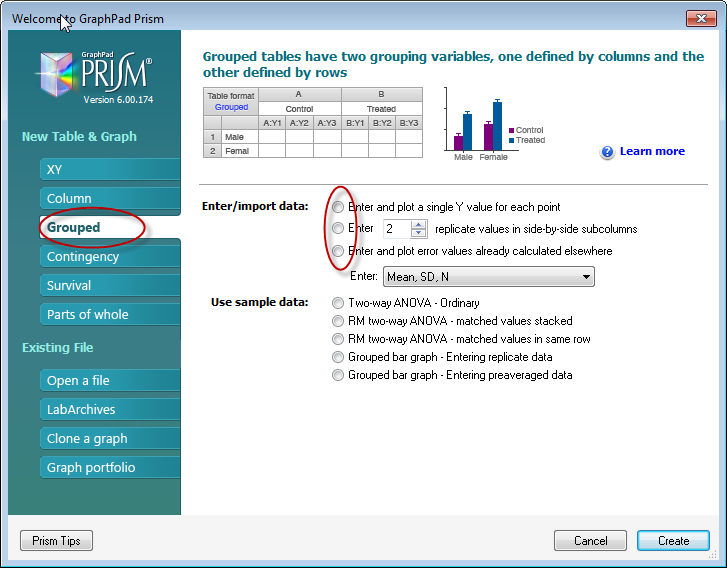

Looking at the mean, median and error graphs, we can choose between a column, a dot, a line, a horizontal column, horizontal dot, and a horizontal line. Whilst formatting and detailing annotation of graphs will be the subject of another walkthrough, we can very quickly see the kind of graphs that are available to us in Prism. When clicking on the graph tab you will get the change graph type option box, and we can switch through the various types of graphs available to us in Prism. Graphs can be found under the graphs tab on the left side of the screen. It is worth remembering that every time you enter data into a table in Prism it will also create a graph for you, so let's look at that graph now. If your data are not paired you need to carry out a standards t-test, but if your data are paired it will increase the power of your study to undertake a paired t-test. In order to carry out a paired t-test each sample will need the have been measured twice, once at control, or maybe baseline, and once after treatment. The data shown here are unpaired, in other words, the values in group A are different experimental outcomes to the values in group B. These two values represent an n-of-8 study where we have produced eight replicates of the experimental outcome, and to undertake a student's t-test we want to compare the mean and standard error of group A with the mean and standard error of group B in order to determine whether there are any differences between these two experimental groups. On the screen we have dataset from a fictitious experiment, where have control values in column A and treated values in column B. At the moment we have no data so I will enter two sets of data in order to carry out a student t-test.

The Prism table, in order to carry out a t-test, is laid out as shown on the screen, with group A, group B, group C, and group D in columns, and the individual replicates of each dataset in the rows. These will, by default, be called data 1, and the graph will be called data 1.įor this demonstration we're going to relabel the data table t-test, you can do this by double clicking on the word data 1, and you'll notice that the graph also changes its name to t-test. It is worth remembering, whenever you create a new file in Prism you will create a data table and a connected graph. Once we've selected column we can click create. The key to using Prism is understanding how the data tables work, and that'll be covered in another tutorial, but for the purposes of this walkthrough we need to select a column table and graph from the menu on the left. In order to continue and complete a student t-test you'll first need to enter your data into Prism. Prism allows you to plot many different types of graphs and produce many different statistical analyses, but for this example we're going to choose probably what is the most simple statistical test you would ever need to carry out in scientific research, and that is a student's t-test.
#Graphpad prism tutorial video error bars how to#
Hello, my name is James Clark from King's College London, and I'm going to show you in this short video how to carry out a t-test using GraphPad Prism. This video is part of the Essential Analysis series, presented by Dr James Clark, from the School of Cardiovascular Medicine and Sciences at King’s College London. Format and annotate a graph of your results.The video also features tips to help you more efficiently navigate and use Prism. This video walks you through the steps required to undertake a t test in Prism.


 0 kommentar(er)
0 kommentar(er)
